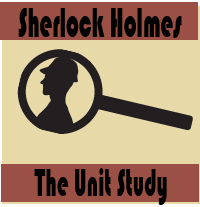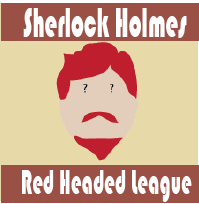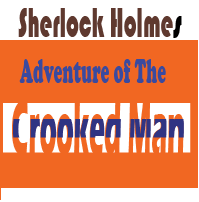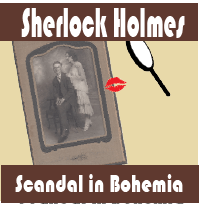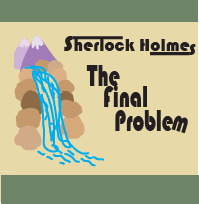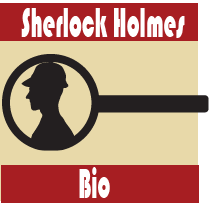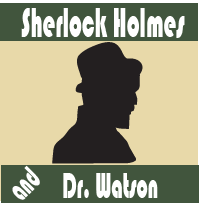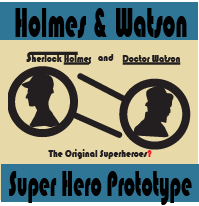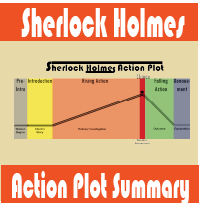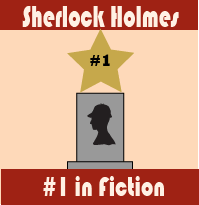Sherlock Holmes: The Unit Study
Sherlock Holmes not only solves crimes, he gets even the most reluctant reader enthusiastically turning the pages of classic literature!
We have a number of resources for the Sherlockian-enthusiast as well as the first-time reader. Investigate how Holmes fits the definitions of classic literature AND popular literature. Check out our unique unit study geared towards middle school students (but can be used by younger and older readers.) Join our Baker Street Treasure Hunt. Search the boxes on the bottom of this page for different articles. And come back for more as we are (slowly) adding more layers to one of our favorite questions: What makes Sherlock Holmes the best selling fiction of all time?
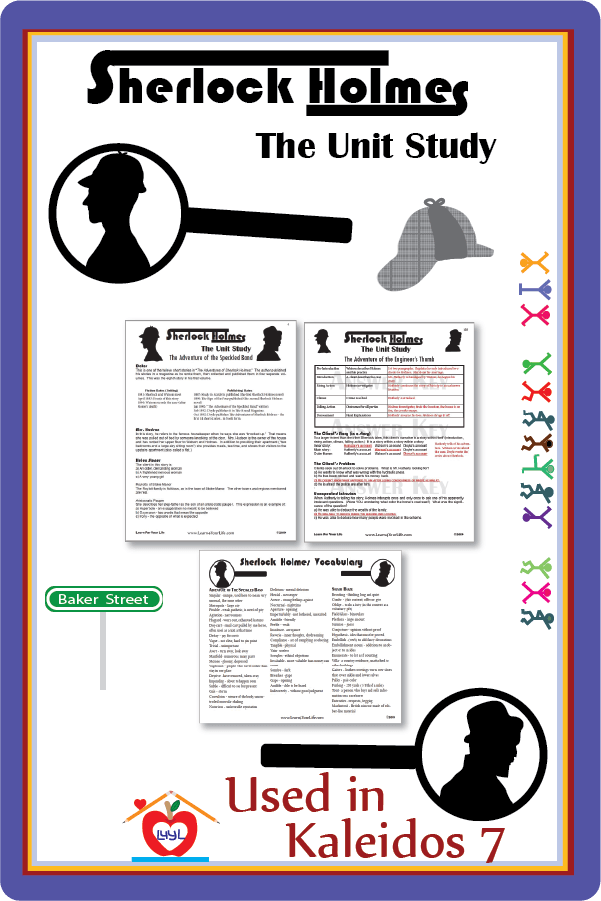
Buy Sherlock Holmes: The Unit Study
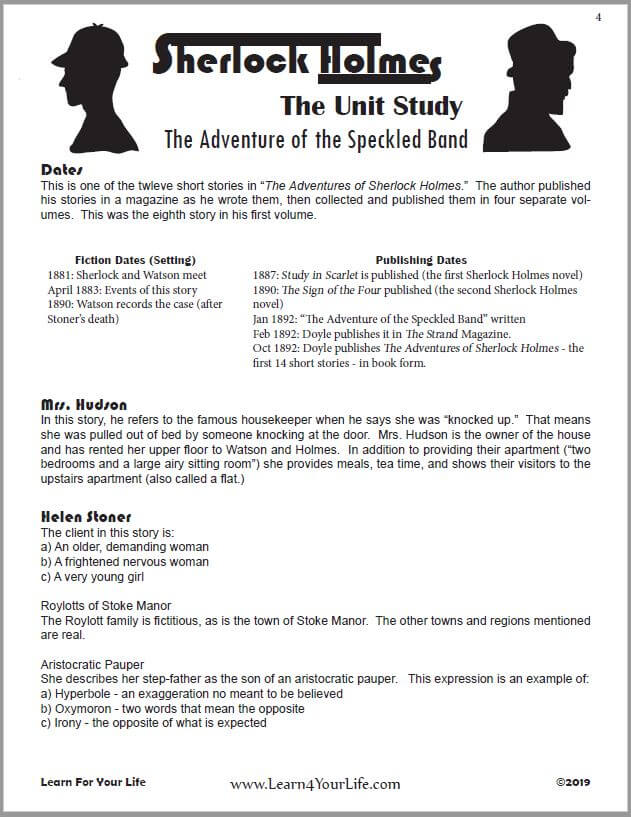
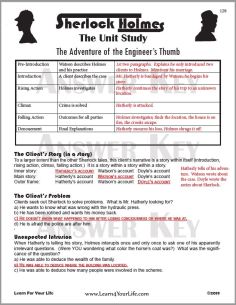
Student Guide AND Teacher's Answer Key Included
$2.99 Download - 183 pages
See below for contents of unit study
Adventure of the Speckled Band
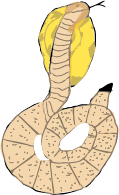
- Six parts of the plot structure (Watson's twist is nothing short of brillant.)
- 3 Reasons this is one of the most popular (if not THE most popular) of the Sherlock tales
- Clues and red herrings
- First Person Secondary Point of View (Doyle nailed this.)
- Locked Room Mysteries
- Background of the Holmes/Watson partnership
- Dating of the stories (Three dates: fictional, historical, and published)
- Flaws in the narrative (ouch! There are some.)
- Hands-on activities for fun
Silver Blaze
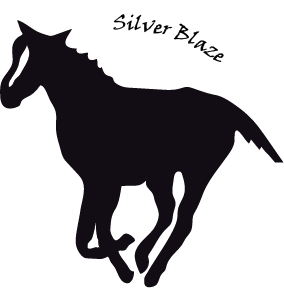
- More about plot and structure
- Unexpected Intrusions (a Sherlock specialty!)
- Compare Criminal, Motivation, and Methods (A good detective discovers all three. But when?)
- Introduce "Holme's Methods"
- Discuss Sherlock's Personality (a hero?)
- Ethics (Would the world's best detective ever do something wrong?
The Red-Headed League

- The Introductory Deductions (another Holmes' Specialty)
- More About Holmes' Character (his dual nature)
- The philosophy of Holmes
- Mood and Tone
- Social Class in Victorian England (one of the themes of the series)
- Fun Facts: Gilt Balls, Black Letter Editions, Rubber, and Parte Carree and the Encylopedia Britannica
The Adventure of the Engineer's Thumb
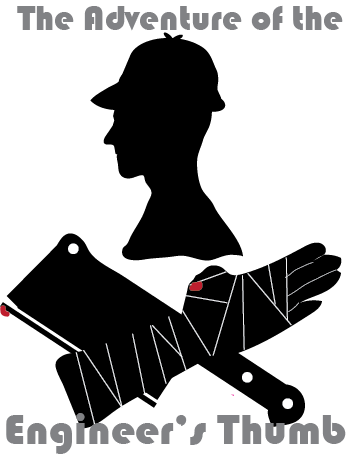
Readers have a new opportunity with this tale: to debate if this is one of Doyle's finest stories - or his worst.
The fine-tuned reader will also discover these features lost to casual observers:
- Fictitious References (People to this day don't know what is real and what isn't.)
- Watson's Dilemma (He had to narrow down which of the thousands of cases he would publish.)
- The Sherlock Canon (The Bible, Sherlock, and only a few other pieces of writing get their own canon)
- Secrets of the Story-tellers technique (revealed by Watson)
- A Closer Look At Watson (He says little about himself, but there's more to him than he reveals.)
- Outer frame, a story with-in a story - with-in a story
- Narrative technique (That's what allows the story with-in a story)
- A double climax
The Adventure of The Crooked Man

Doyle delivered suspense and changed his plot structure - even though he let his detective do almost all the investigation without Watson or us tagging along.
- A closer look at Sherlock's philosophy
- Watson's role in this story and in the series
- Play on Words (Who exactly was "the crooked man?"
- Alteration in Point of View (First Person Secondary with Primary Person Narration - nobody does this!)
- Narrative-Action-Narrative
- Type of Detective Story
- Symbolism - the missing key
- Background info: Baker Street Boys and a mongoose
A Scandal in Bohemia
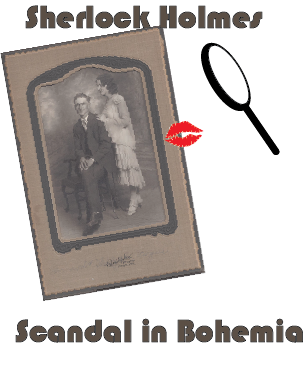
- What makes Irene Adler an enigmatic character?
- Fictitious References - another technique Doyle uses to add depth to Sherlock's career
- Scandals - how many different scandals did Doyle subject his Victorian readers to in THIS story?
- First person secondary narrative - Doyle frequently stretches his POV to do new things
- Foils in characters (Irene vs the King)
- Holmes and Women (People have a hay-day with this.)
- Contradictions in the Plot
- Money and Holmes
- Fun facts: Bohemia, Cocaine, Cabinet Photographs, Boswell, Langham Hotel, La Scala and plumber's smoke rocket
- Figures of Speech (Oxymoron, Polyptoton, Antithesis)
Adventure of the Dancing Men

In The Adventure of the Dancing Men analysis, our literary sleuths will discover:
- Series of Inferences
- Pre-Introduction Pronouncement (a frequently missed element Doyle mastered)
- Character Descriptions par excellence
- Contrasts in tone
- Could Sherlock fail???
- Victorian women and cultural analysis in literature
- The irony of honor (in this story, anyway)
- Background Info: Watson's checkbook and country squires
- Literary Techniques: Verbal kickback and foreshadowing
The Final Problem

- The flagrantly wicked Professor Moriarty and a contest of wills (described with a mastery of speech)
- The professor was bad. Really bad. But just what had he done?
- Symbol - The Alpine Stock
- Reichenbach Falls - some might find this location beautiful (but Watson described it in chilling terms)
- Readership and Holmes both plunged
- Doyle's decision: Fail or Win?
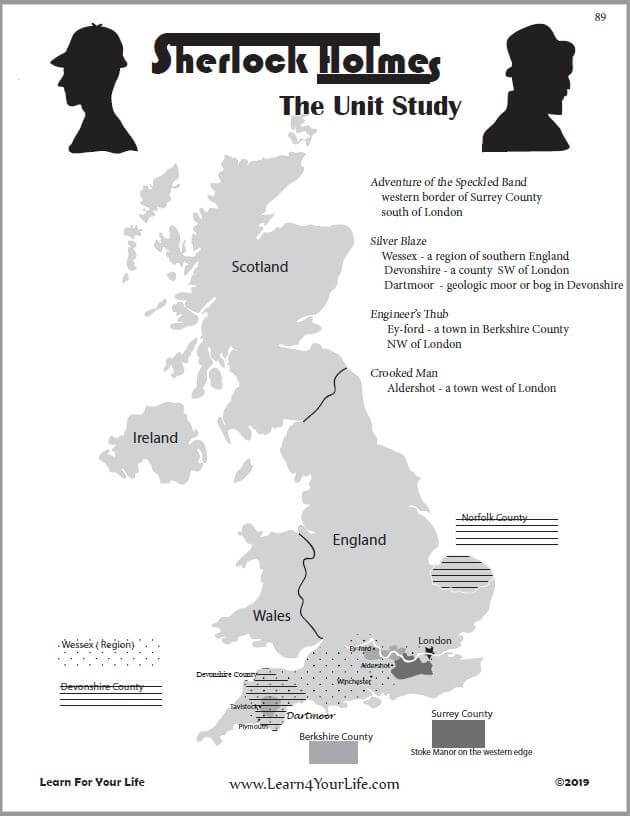
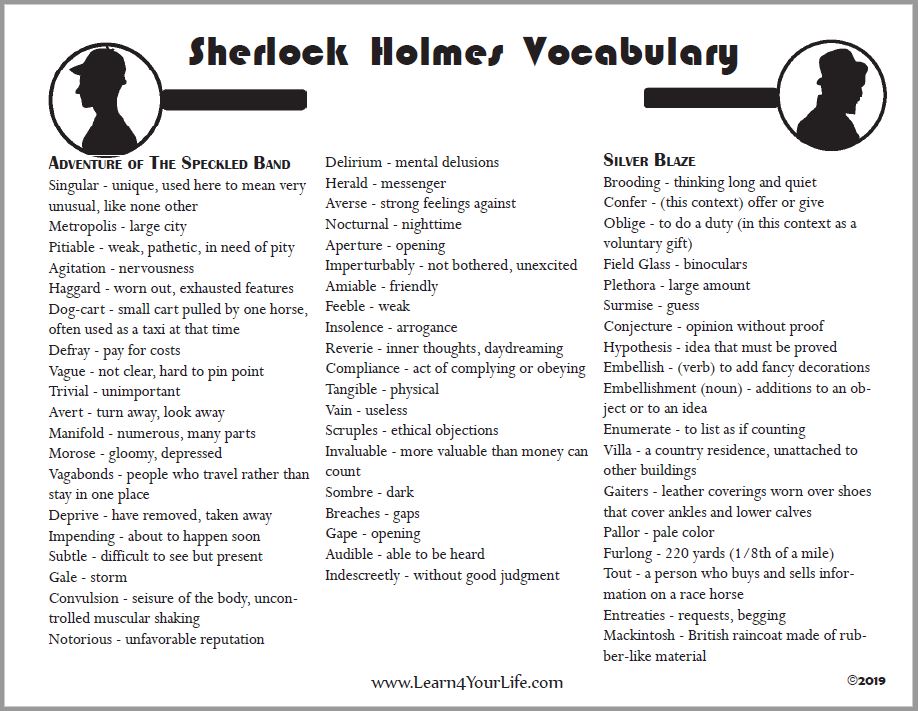
Tools of the Wide-Eyed Reader of Detective Stories
Our unit study uncovers literary features that put Doyle, Holmes and Watson on the literary hall of fame. Conduct your own investigation and see how many of these you can uncover in each story:- Pre-Introductions - Doyle added a unique part to his action plots. And it took the Sherlock stories out of the category of popular literature into the permanent realm of classic literature.
- First person secondary perspective. Sherlock uses Watson for one purpose, but Doyle used him for another reason.
- Singular use of the word "singular" - It's Doyle's favorite word apparently. It does have the effect of marking Watson, Holmes, and Doyle as precise gentlemen of the British aristocracy.
- Scenic Descriptions - Missed by many readers and analysts alike, Doyle provides one - and only one - short description of the outdoor scenery (usually sky and weather) in all stories but two.
- Introductory Deductions - Classic Holmes: and readers never tire of it.
- Unexpected Intrustions - Holme's has this little habit of interupting his clients to ask the most unexpected and irrelevant questions. (Hint: they are never irrelevant.)
- Red Herrings - Red herrings are used to throw the reader off track. If every detail and clue were significant the savvy reader might put them all together so unimportant details are inter-mixed with real clues.
- Fictitious References - Here's a technique that adds to the authenticity of the story: Sherlock makes references to past clients and travels. He mixes real events, real places, real people with fiction.
- Pre-Introduction Pronouncements - Want to know how Sherlock always gets his man? He often makes a pronouncement in the Pre-Introduction phase which subsequently becomes a self-fulfilling prophecy. An interesting literary bread-crumb trail from Doyle.
- Variety of Outcomes - What's the use of a predictable plot if Holmes always sends the bad guy to jail. He may not lose many cases (actually, he does lose a few) but even when he wins the outcomes are predictably unpredictable.
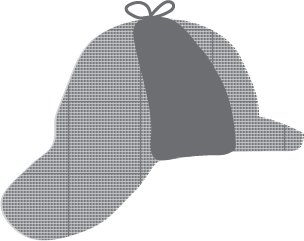
Buy Sherlock Holmes: The Unit Study


Student Guide AND Teacher's Answer Key Included
$2.99 Download - 183 pages
Eight of the most popular tales demonstrate how to investigate a detective story.
![]()
Sherlock Holmes Pages
A catalog of our pages on Sherlock Holmes.


About Our Site
Hands-On Learning



